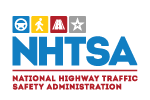Older Drivers

Getting older does not necessarily mean a person's driving days are over. But it is important to plan ahead and take steps to ensure the safety of your loved ones on the road. NHTSA offers free materials to help you learn more about how to recognize and discuss changes in your older loved one's driving.
Latest News
- Clearinghouse for Older Road User Safety site launches
 As America's driving population continues to age, resources and infrastructure that address the needs of those drivers are becoming increasingly critical across the country. The Roadway Safety Foundation, with support from the Federal Highway Administration and the National Highway Traffic Safety Administration, is working to meet these needs, most notably with the new Clearinghouse for Older Road User Safety (ChORUS). The Clearinghouse's resources are as comprehensive as its audience is diverse: highway engineers will find technical manuals, motor vehicle administrators will find licensing policies by state, medical professionals will find the latest research, older drivers will find self-assessments and tips, and family and caregivers will find a supportive online community. Learn more
As America's driving population continues to age, resources and infrastructure that address the needs of those drivers are becoming increasingly critical across the country. The Roadway Safety Foundation, with support from the Federal Highway Administration and the National Highway Traffic Safety Administration, is working to meet these needs, most notably with the new Clearinghouse for Older Road User Safety (ChORUS). The Clearinghouse's resources are as comprehensive as its audience is diverse: highway engineers will find technical manuals, motor vehicle administrators will find licensing policies by state, medical professionals will find the latest research, older drivers will find self-assessments and tips, and family and caregivers will find a supportive online community. Learn more
- Jan. 2016: Clinician's Guide to Assessing and Counseling Older Drivers, 3rd Edition
The American Geriatrics Society prepared this guide in cooperation with NHTSA to help healthcare professionals prevent motor vehicle crashes and injury to older adults. The guide assists clinicians in assessing older drivers at risk for crashes and counseling older drivers to help enhance their driving safety. Resources for easing the transition to driving retirement when necessary are also available.
- Key Provisions of State Laws Pertaining to Older Driver Licensing Requirements
- Older Driver Highway Safety Program Guidelines
These are based on best practices around the country and include countermeasures that can be implemented to ensure the safety of older drivers, including at-risk drivers. The guidelines encourage state highway safety offices to work closely with driver license officials, state departments of transportation, medical providers and aging services providers, among others.
- Traffic Safety Fact
In 2012, there were 5,560 people 65 and older killed and 214,000 injured in motor vehicle traffic crashes. These older people made up 17% of all traffic fatalities and 9% of all people injured in traffic crashes during the year. Compared to 2011, fatalities among people 65 and older and injured people in this age group increased by 16%.
Resources for People Around Older Drivers
-
Older Driver Highway Safety Program Guidelines
These are based on best practices around the country and include countermeasures that can be implemented to ensure the safety of older drivers, including at-risk drivers. The guidelines encourage state highway safety offices to work closely with driver license officials, state departments of transportation, medical providers and aging services providers, among others. -
Adapting Motor Vehicles for Older Drivers
Evaluate your needs, making sure the vehicle "fits" you properly, choosing appropriate features, installing and knowing how to use adaptive devices, practicing good vehicle maintenance. -
How to Understand and Influence Older Drivers
Talking with an older person about their driving is often difficult. Most of us delay that talk until the person’s driving has become what we believe to be dangerous. At that point, conversations can be tense and awkward for everyone involved. But there are things you can say and do to make those conversations more productive and less tense.
